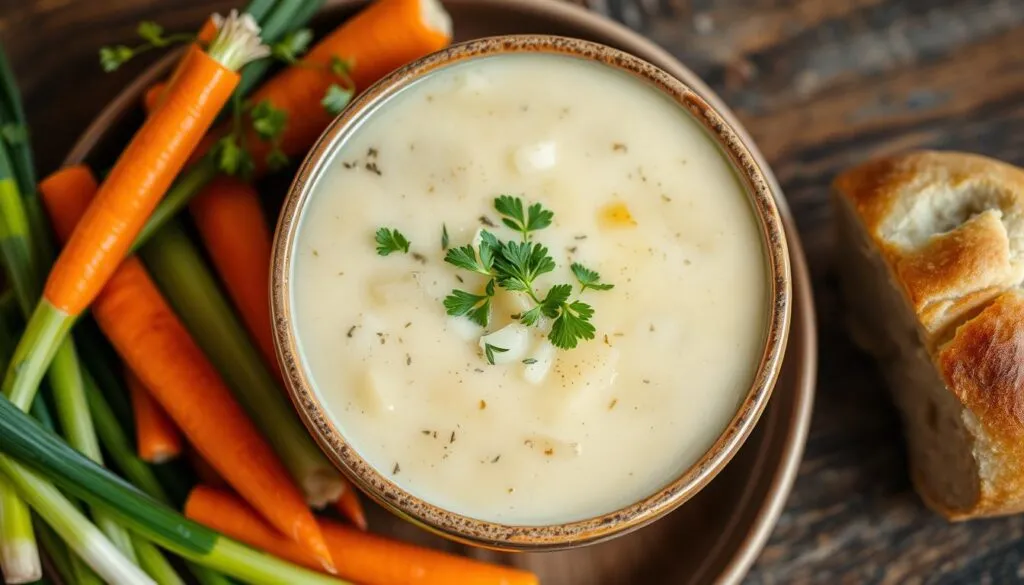Wondering why potato soup is a nutritious meal choice? It’s because of its rich nutritional profile. This makes it a great addition to a healthy diet. Potato soup is packed with vitamins and minerals, making it a comforting and delicious option.
Exploring potato soup’s benefits shows it’s versatile and can be tailored to your taste. It’s creamy, easy, and vegetarian, perfect for a nutritious meal. Its nutritional profile and health benefits make it a great choice for a balanced diet. So, why is potato soup good for you? It’s all about its rich nutritional profile and health benefits.
Looking at potato soup’s nutritional value is key. It combines potatoes, leeks, and celery for a varied nutritional profile. Enjoying a warm bowl of potato soup offers health benefits, making it a great diet addition. So, next time you wonder about potato soup, remember its nutritional profile and health benefits.
Understanding the Basic Nutrition of Potato Soup

Potato soup is a nutritious meal that has been loved for centuries. It’s a big part of Norwegian culture, helping people stay healthy. Potatoes are packed with nutrients, giving us all the proteins and amino acids we need.
A medium potato is mostly water, with 79% of it. It also has 10 vitamins and minerals, 4 grams of fiber, and 4 grams of protein. This makes it a great base for a healthy soup. When we talk about potato soup nutrition, we must look at the whole picture. This includes the homemade recipe and creamy variations.
Key Macronutrients in Potato Soup
Potato soup is mostly carbs, with 30g to 40g in a serving. It also has about 4g of dietary fiber. This fiber helps with digestion and keeps you full.
Essential Vitamins and Minerals
Potatoes are full of vitamins and minerals, like Vitamin C. Vitamin C is key for a strong immune system. A serving of potato soup gives you about 15% of the daily Vitamin C you need.
Caloric Content and Portion Sizes
A serving of potato soup has about 180 calories. This makes it a low-calorie meal. When making homemade potato soup, remember to watch your portion sizes. This helps you meet your dietary needs without eating too much.
Why Is Potato Soup Good for You? The Scientific Answer
Potato soup is a nutritious and tasty addition to a healthy diet. It’s packed with antioxidants and fiber. This makes it a great choice for those looking for a simple potato soup recipe.
Research shows that eating soup before a meal can cut down on calories by 20%. This is good news for those trying to manage their weight. Also, eating plant-based soups like potato soup can lower triglycerides and improve blood health.
Some key benefits of potato soup include:
- High content of antioxidants and fiber
- Potential to reduce caloric intake and support weight management
- May help lower triglyceride levels and improve blood health

To get the most health benefits from potato soup, choose a simple recipe with nutritious ingredients. This way, you can enjoy a tasty and healthy meal that boosts your overall health.
| Nutrient | Amount (per serving) |
|---|---|
| Calories | 150-200 |
| Protein | 3-5g |
| Fat | 5-7g |
| Carbohydrates | 20-25g |
The Benefits of Homemade Potato Soup
When you make homemade potato soup, you control what goes into it. You can choose to make it creamy or vegetarian, based on what you like. This way, you get a meal that’s both healthy and tasty, just how you want it.
Another plus is that homemade potato soup is easy on your wallet. Potatoes are cheap, and making a big batch can save you money. Plus, you can add your favorite spices and ingredients to make it special.

- Control over ingredients
- Cost-effectiveness
- Customization options
- Nutritious and delicious meal
| Ingredient | Quantity | Calories |
|---|---|---|
| Potatoes | 1 ½ pounds | approximately 600 |
| Bacon | 3 strips | approximately 120 |
| Full fat milk | 1/2 cup | approximately 75 |
By making your own potato soup, you get a meal that’s both healthy and delicious. Whether you like it creamy or vegetarian, the benefits are clear.
How Potato Soup Supports Your Immune System
Potato soup is a nutritious meal that boosts your immune system. It’s packed with vitamins and minerals like vitamin C and B6. These help fight off colds and flu. To make it, use leeks, garlic, and ginger for their immune-boosting powers.
Some key ingredients in potato soup include:
- Leeks, which contain antioxidants like flavonoids
- Garlic, which has antibacterial and antiviral properties
- Ginger, which helps reduce nausea and fight infections
- Spinach and kale, which are high in vitamins A, C, K, iron, and calcium
- Chickpeas, which are rich in protein and fiber, and contain zinc and folate
These ingredients, along with vegetable broth and lemon juice, make a tasty and healthy soup. It’s perfect for supporting your immune system, making it a great choice during flu season.

Adding potato soup to your diet can improve your health. Its easy recipe and many health benefits make it a quick and nutritious meal option.
Making Your Potato Soup Healthier
To make your potato soup healthier, use a low-calorie recipe with gluten-free ingredients. Choose gluten-free broth and watch what you add. For a hamburger version, pick lean ground beef or a plant-based option to cut calories and fat.
Start with a good base of vegetables like onions, carrots, and celery. Use low-sodium broth. Add healthy toppings like fresh herbs, low-fat sour cream, or shredded cheese. Remember, a serving size is about 1 cup.
Here are some tips for a healthier potato soup: * Use a low-calorie potato soup recipe * Incorporate gluten-free ingredients * Choose lean protein sources for hamburger potato soup * Be mindful of portion sizes
| Nutrient | Amount per serving |
|---|---|
| Calories | 178.4 kcal |
| Carbohydrates | 27.5 g |
| Protein | 4.3 g |
| Fat | 6.3 g |
Dietary Variations for Different Needs
There are many ways to make potato soup fit your dietary needs. For a vegetarian version, use vegetable broth and add your favorite veggies. If you need a gluten-free option, choose gluten-free broth and watch your ingredients.
For a soup that’s lower in calories, use less cream and add more veggies. This way, you can enjoy a tasty potato soup that’s right for you.
Here are some tips to make your potato soup more inclusive:
- Use gluten-free ingredients for those with gluten intolerance.
- Add chickpeas or tofu for a vegetarian or vegan soup.
- Use less cream and cheese for a lower-calorie soup.
With these simple changes, you can have a healthy and tasty potato soup. You can choose from vegetarian, gluten-free, or low-calorie options. The possibilities are endless.
The Role of Potato Soup in Weight Management
Potato soup can be great for managing weight. It’s filling and has few calories. A medium potato, cooked alone, has about 147 calories. It also has 1.4 grams of fiber, which helps you feel full longer.
There are smart ways to make potato soup for weight control. Use vegetable broth instead of cream or cheese to cut calories. You can also make it gluten-free or with hamburger for a healthier, more filling meal.
- High fiber content, which aids in digestion and satiety
- Low calorie count, ideal for those watching their weight
- Can be made with lean proteins and veggies for a balanced meal
Potato soup can be a tasty, healthy part of a weight management diet. Just use smart ingredients and methods. Adding low-calorie, gluten-free, or hamburger potato soup to your meals can help you reach your weight goals. It’s a healthy, filling choice.
Seasonal Benefits of Potato Soup
Potato soup is a nutritious and delicious meal option, perfect for winter. It offers many health benefits and is a great choice for a comforting meal. With an easy potato soup recipe, you can enjoy its benefits while meeting your dietary needs.
Potato soup is high in fiber, which helps with digestion and bowel movements. It also has soothing properties that can ease digestive inflammation. Plus, potatoes are a good source of complex carbohydrates, making them filling and satisfying.
Here are some tips for making potato soup a part of your seasonal diet:
- Choose seasonal ingredients, such as potatoes and leeks, to ensure the best flavor and nutrition.
- Use an easy potato soup recipe that incorporates lean proteins and healthy fats to increase the nutritional density of the dish.
- Consider adding other seasonal vegetables, such as carrots and celery, to increase the nutrient content of the soup.
By adding potato soup to your winter diet, you can enjoy its health benefits while staying warm. Its easy recipe and many health benefits make it a great seasonal meal choice.
| Seasonal Ingredient | Nutritional Benefit |
|---|---|
| Potatoes | High fiber content, complex carbohydrates |
| Leeks | Rich in vitamins and minerals, antioxidants |
| Carrots | High in vitamin A, fiber, and antioxidants |
Common Mistakes to Avoid When Preparing Potato Soup
When making homemade potato soup, it’s key to avoid common mistakes. Overcooking can make your soup mushy and unappetizing. Cook your potatoes until they’re tender but not too soft.
Using low-quality ingredients is another mistake to steer clear of. For a better soup, choose high-starch potatoes like Russet or Idaho. Also, use a rich, flavorful broth to boost the taste. Don’t overdo it with salt, as too much can spoil the flavor.
Here are some common mistakes to avoid when preparing potato soup:
- Overcooking the potatoes
- Using low-quality ingredients
- Adding too much salt
- Not sautéing aromatics properly
- Using water instead of broth
To make a delicious homemade potato soup, use top-notch ingredients. Cook your potatoes with care and season with caution. Follow these tips to create a creamy, easy potato soup that everyone will love.
| Mistake | Effect on Soup | Correction |
|---|---|---|
| Overcooking potatoes | Mushy texture | Cook until tender but firm |
| Using low-quality ingredients | Poor flavor | Choose high-starch potatoes and rich broth |
| Adding too much salt | Overseasoning | Add salt gradually and taste |
Best Practices for Storage and Reheating
Storing and reheating your homemade potato soup is key. Whether it’s creamy or vegetarian, keeping it fresh is important. The right storage and reheating methods ensure your soup stays safe and tasty.
Cool your soup to a safe temperature within two hours of cooking. Use an ice bath or refrigerate in shallow containers. Once cooled, refrigerate or freeze it for later.
Proper Storage Methods
Refrigerate your soup in a covered container at 40 degrees Fahrenheit or below. It can last three to five days in the fridge. For freezing, use airtight containers or freezer bags with space for expansion.
Safe Reheating Guidelines
Reheat your soup to 165 degrees Fahrenheit for safety. You can use the stovetop, microwave, or oven. Thaw frozen soup in the fridge or microwave before reheating.
- Label containers with the date
- Use smaller portions
- Avoid overfilling containers
- Check for spoilage before eating
Follow these storage and reheating tips to enjoy your homemade potato soup. Whether it’s creamy or vegetarian, it will stay fresh and safe.
Conclusion: Making Potato Soup Part of Your Healthy Diet
Potato soup is a nutritious and versatile meal that should be in your diet. It’s full of vitamins, minerals, and macronutrients. This makes it great for your body’s health.
The health benefits of potato soup go beyond just nutrition. It boosts your immune system, helps with weight management, and is good all year.
Adding potato soup to your meals can make your diet healthier. It’s a tasty, comforting dish that’s good for you. You can stick to the classic recipe or try new twists.
So, why not include potato soup in your meals? It’s a great way to nourish your body and enjoy delicious flavors.
FAQ
What are the key macronutrients in potato soup?
Potato soup is rich in carbs, thanks to the potatoes. It also has protein from milk, cream, or broth. Plus, it has a bit of fat, depending on the recipe.
What essential vitamins and minerals are found in potato soup?
Potato soup is packed with vitamins and minerals. It has vitamin C, vitamin B6, potassium, and magnesium. The exact nutrients depend on the recipe and ingredients.
What is the caloric content and typical portion size of potato soup?
The calories in potato soup vary by recipe. A 1-cup serving of homemade soup can have 200 to 400 calories. This depends on ingredients like cream and butter.
What are the health benefits of potato soup?
Potato soup is full of antioxidants and fiber. These can boost your health. The fiber aids digestion, and antioxidants support your immune system.
What are the benefits of making homemade potato soup?
Making your own potato soup lets you pick the ingredients. It’s cheaper and can be tailored to your taste. You can make it creamy, easy, or vegetarian.
How does potato soup support the immune system?
Potato soup is rich in vitamin C, key for a strong immune system. Vitamin B6 and minerals also help keep your immune system healthy.
How can I make my potato soup healthier?
For a healthier soup, use low-fat milk or vegetable broth. Add toppings like Greek yogurt, chives, or roasted veggies. Watch your portion sizes to keep calories down.
What dietary variations are available for potato soup?
You can make potato soup for different diets, like vegetarian or gluten-free. Adjust the ingredients and cooking methods to fit your dietary needs.
How can potato soup support weight management?
Potato soup can help with weight management because it’s filling. Choose low-fat dairy and control portions for a balanced diet.
What are the seasonal benefits of potato soup?
Potato soup is comforting and affordable in winter. It’s a nourishing meal that’s easy to make, perfect for the season.
What are some common mistakes to avoid when preparing potato soup?
Avoid overcooking potatoes and use quality ingredients. Adjust cooking time and temperature for the right texture and flavor.
How should I store and reheat my homemade potato soup?
Store your soup in an airtight container in the fridge. Reheat it on the stovetop or microwave. Make sure it’s hot before serving.

